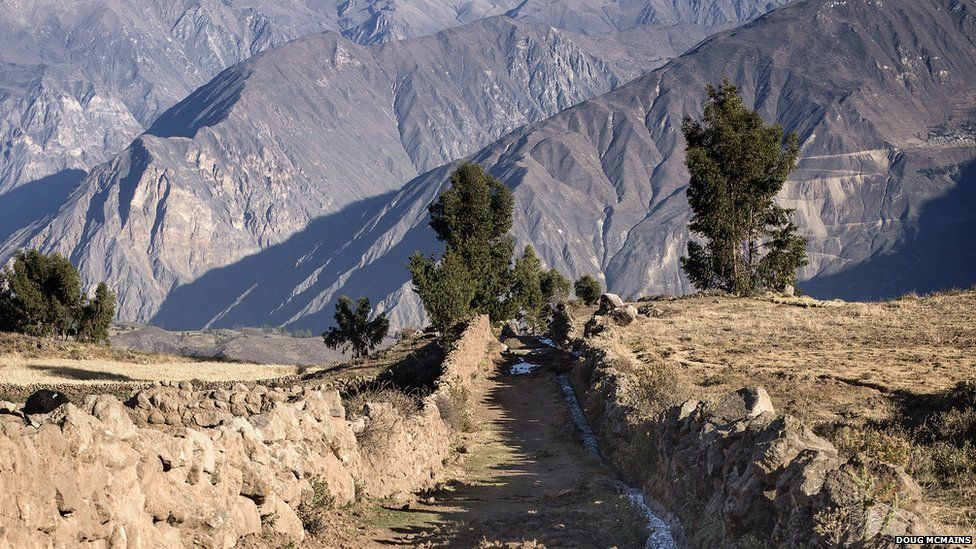Inca Road: The ancient highway that created an empire
- Published

Do long-dead builders have the answer to more sustainable road development? A new exhibit at the Smithsonian Institution in Washington DC shows why the Incan kingdom built a lasting infrastructure.
The Inca Road is one of the most extraordinary feats of engineering in the world. By the 16th Century it had helped transform a tiny kingdom into the largest empire in the Western hemisphere.
And to the envy of modern engineers, substantial parts of the 24,000-mile (39,000-km) network survive today, linking hundreds of communities throughout Argentina, Bolivia, Chile, Colombia, Ecuador and Peru.
Incredibly, it was constructed entirely by hand, without iron or wheeled transportation.
An exhibition at the National Museum of the American Indian is the result of six years of research that concludes the ancient Incas knew a thing or two about water.
"When you look at Machu Picchu in Peru - that wonderful structure on top of the mountain that millions of tourists visit every year - what most people don't see and unfortunately don't know, is that the real marvel is underneath it all," says Jose Barreiro, co-curator of The Great Inka Road (the Smithsonian uses the Quechua spelling of Inca).
The dry stone monument sits on top of a complex irrigation system of culverts and channels that control the flow of water into fountains that still work today. And while archaeologists have known that for some time, the exhibition reveals the extent of the Inca understanding of water and how they applied the same technology to road building.
"Every year, water destroys many modern roads. But the Inca roads tend to stay," says Barreiro.
"The constructions were built with seismic events in mind and that's what engineers today are excited to study - how we can benefit from that knowledge."
Sustainability was the key to success. The Incas paid attention to local conditions, using local materials and working with the landscape.
On steep terrain they built steps to dissipate the water's energy and counter erosion. At high altitudes they paved the way with local stone to protect the surface from ice and snowmelt, and when they needed supporting walls they left holes for the water to drain.
"The Incas took care to preserve the environment and the road is a part of Mother Nature," says Ramiro Matos, the exhibition's lead curator and a native Quechua speaker.
He grew up walking the Inca Road (also known as the Qhapaq Nan) in the central highlands of Peru and says he has a strong emotional connection.
"The road is not just a physical road," he says. "It's a cosmological road, and modern people consider it a living road."
"The Kallawaya (travelling doctors from Bolivia) still use the road to walk and recycle their energy. They say the road has a spirit."
The empire's spiritual centre and capital was Cusco in southeastern Peru. All roads emanated from the city. Along the routes, sacred places were marked by wakas - stone outcroppings, buildings or even the confluence of rivers that served as altars to the Pachamama (Mother Earth) or Inti (the sun god).
Many of those traditions continue today and part of the exhibition explores the way the road still binds people of different ethnicities across the vast Andean region.
"We contacted the Inca descendents and talked to them about how they feel about the road and its meaning," says Matos. "We have had the historical investigation, now we have the oral history."
The research reveals a different side to the Incas, who are often better remembered for their notorious blood lust and predilection for human sacrifice. But portraying them as environmentalists does not negate their less attractive characteristics.
"We're not projecting that there are perfect cultures," says Barreiro. "But our focus was to drop the macabre and look at the other 90% of life, how it was organised and the genius and the impetus of the Incas to carry out this particular task [of building the road]."
He says Inca society was certainly "strict" but at its heart was a philosophy of reciprocity. The Incas gave back to nature and everybody knew their role in the community.
"The entire environment was alive. Everything from the stones to the animals to the cosmos needed some kind of interaction with a human being in prayer, connectivity or appreciation.
"Everything was organised and regulated by the state. You had the masters of the road, the masters of the bridges, thekhipu - a knotted device that kept track of people on the road, products, organised censuses of people and news from everywhere in the empire."
Examples of the khipu and 140 other objects - some more than 2,000 years old - are included in the exhibition to help illustrate the development of the Inca Road and its spiritual concepts.
But ironically, it was the Inca Road that hastened the demise of its creators.
When the Spanish reached the Pacific coast in 1532 the empire was weakened by internal fighting and smallpox. And the same road that had given the Inca unprecedented access to every part of their kingdom now did the same for the conquistadors.
Within a year they had consolidated their rule and stripped Cusco of its power, establishing Lima as the new colonial capital. The Qhapaq Nan fell into disrepair. Routes that had been vital to the Inca communities were disregarded by the Spanish who were more interested in accessing the fallen empire's gold and silver mines.
But the Inca Road lives on, combining history with new purpose.
- Published30 June 2015
- Published18 June 2015
- Published12 May 2015
- Published30 April 2015